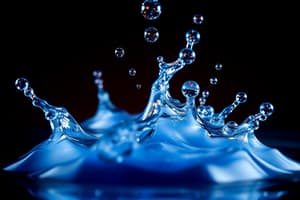Podcast
Questions and Answers
Which type of crystal is known for having atoms connected with covalent bonds?
Which type of crystal is known for having atoms connected with covalent bonds?
- Molecular Crystals
- Ionic Crystals
- Metallic Crystals
- Covalent Crystals (correct)
Which type of crystal is characterized by a network of molecules held by weak London dispersion forces, dipole-dipole forces, or hydrogen bonds?
Which type of crystal is characterized by a network of molecules held by weak London dispersion forces, dipole-dipole forces, or hydrogen bonds?
- Ionic Crystals
- Covalent Crystals
- Molecular Crystals (correct)
- Metallic Crystals
What property of ionic crystals makes them very brittle?
What property of ionic crystals makes them very brittle?
- Low melting point
- Presence of ions
- Different-sized particles (correct)
- High density
Which type of crystal is known for being a good conductor only after liquefying?
Which type of crystal is known for being a good conductor only after liquefying?
Which crystal type contains metal atoms held together by intermolecular forces?
Which crystal type contains metal atoms held together by intermolecular forces?
Why are molecular crystals poor conductors of heat and electricity?
Why are molecular crystals poor conductors of heat and electricity?
What contributes to the high melting points of covalent crystals?
What contributes to the high melting points of covalent crystals?
Which crystal type is characterized by being malleable and ductile?
Which crystal type is characterized by being malleable and ductile?
What makes metallic crystals good conductors of heat and electricity?
What makes metallic crystals good conductors of heat and electricity?
What property leads to the brittleness of ionic crystals?
What property leads to the brittleness of ionic crystals?
Flashcards are hidden until you start studying
Study Notes
Properties of Liquids
- Surface tension is the measure of the elastic force in the surface of a liquid.
- Vapor pressure is the pressure exerted by the gas in equilibrium with a liquid in a closed container at a given temperature.
- Viscosity is a measure of the resistance of fluid to flow.
- Boiling point is the temperature at which the liquid converts into a gas.
- Capillary action is the tendency of a liquid to rise in narrow tubes or be drawn into small openings.
- Molar heat of vaporization is the energy required to vaporize 1 mole of a liquid at a given temperature.
Types of Solids
- Crystalline solids have a crystal lattice structure, with a combination of unit cells forming a network.
- Amorphous solids have a random orientation of particles.
- Crystalline solids have distinct melting points, are generally incompressible, and have a repeating geometric structure.
- Amorphous solids melt gradually over a range of temperature, can be compressed, and have a random arrangement of particles.
Properties of Crystalline Solids
- Crystal lattice is a combination of unit cells forming a network.
- Unit cell is the smallest repeating structure.
- Crystalline solids have distinct melting points because applying heat breaks the bonds at the same time.
- They are generally incompressible because of the repeating geometric structure.
Properties of Amorphous Solids
- Amorphous solids have a random orientation of particles.
- They melt gradually over a range of temperature because the bonds do not break at once.
- They can be appreciably compressed because of the random arrangement of particles.
Types of Crystals
- Ionic crystals are made of different-sized particles, have high melting points and boiling points, and are not good conductors of heat and electricity as solids.
- Molecular crystals are held by weak London dispersion forces, dipole-dipole forces or hydrogen bonds, have low melting points, and are poor conductors of heat and electricity.
- Covalent crystals are extremely strong and very hard to break, have high melting points, and are poor conductors of heat and electricity.
- Metallic crystals are good conductors of heat and electricity, vary in melting points and hardness, and are malleable and ductile.
Examples of Solids
- Crystalline solids: Sugar, Salt, Ice, Diamond, MSG
- Amorphous solids: Glass, Plastics, Cotton Candy, Coal
- Ionic crystals: NaCl, LiF, MgO
- Molecular crystals: Sucrose, Ice, Carbon Dioxide (Dry Ice), Sulfur Dioxide
- Covalent crystals: Diamonds, Graphite, Quartz
- Metallic crystals:
Studying That Suits You
Use AI to generate personalized quizzes and flashcards to suit your learning preferences.




